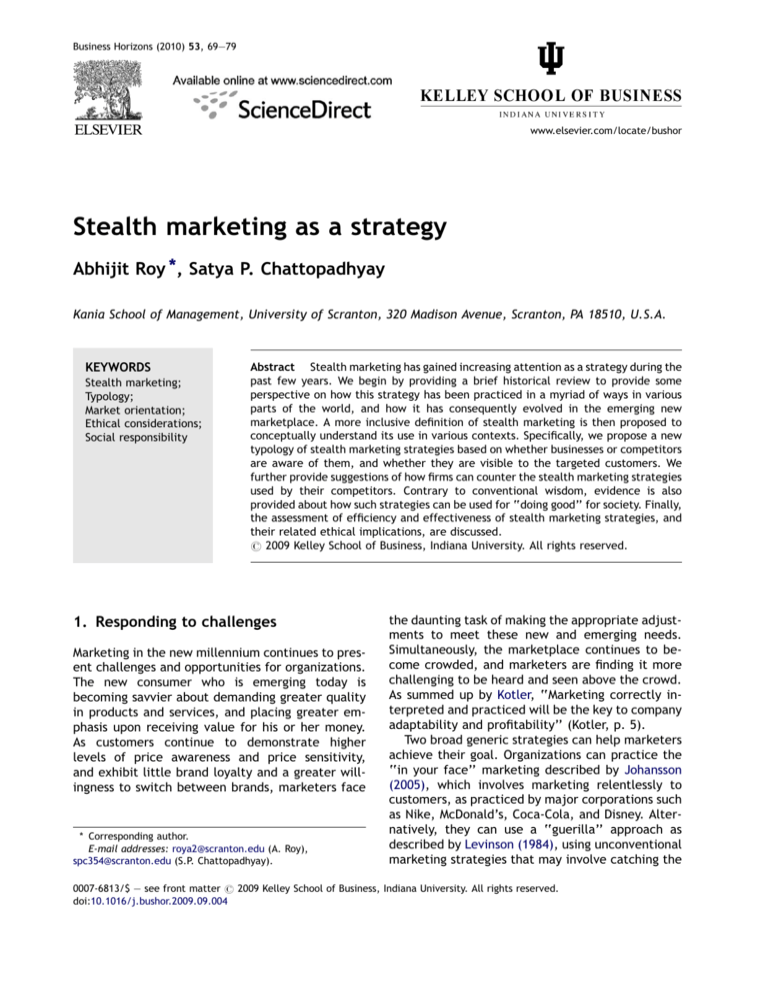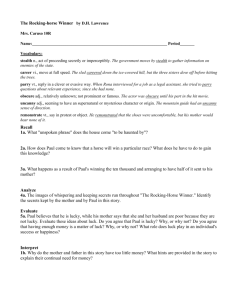
Business Horizons (2010) 53, 69—79
www.elsevier.com/locate/bushor
Stealth marketing as a strategy
Abhijit Roy *, Satya P. Chattopadhyay
Kania School of Management, University of Scranton, 320 Madison Avenue, Scranton, PA 18510, U.S.A.
KEYWORDS
Stealth marketing;
Typology;
Market orientation;
Ethical considerations;
Social responsibility
Abstract Stealth marketing has gained increasing attention as a strategy during the
past few years. We begin by providing a brief historical review to provide some
perspective on how this strategy has been practiced in a myriad of ways in various
parts of the world, and how it has consequently evolved in the emerging new
marketplace. A more inclusive definition of stealth marketing is then proposed to
conceptually understand its use in various contexts. Specifically, we propose a new
typology of stealth marketing strategies based on whether businesses or competitors
are aware of them, and whether they are visible to the targeted customers. We
further provide suggestions of how firms can counter the stealth marketing strategies
used by their competitors. Contrary to conventional wisdom, evidence is also
provided about how such strategies can be used for ‘‘doing good’’ for society. Finally,
the assessment of efficiency and effectiveness of stealth marketing strategies, and
their related ethical implications, are discussed.
# 2009 Kelley School of Business, Indiana University. All rights reserved.
1. Responding to challenges
Marketing in the new millennium continues to present challenges and opportunities for organizations.
The new consumer who is emerging today is
becoming savvier about demanding greater quality
in products and services, and placing greater emphasis upon receiving value for his or her money.
As customers continue to demonstrate higher
levels of price awareness and price sensitivity,
and exhibit little brand loyalty and a greater willingness to switch between brands, marketers face
* Corresponding author.
E-mail addresses: roya2@scranton.edu (A. Roy),
spc354@scranton.edu (S.P. Chattopadhyay).
the daunting task of making the appropriate adjustments to meet these new and emerging needs.
Simultaneously, the marketplace continues to become crowded, and marketers are finding it more
challenging to be heard and seen above the crowd.
As summed up by Kotler, ‘‘Marketing correctly interpreted and practiced will be the key to company
adaptability and profitability’’ (Kotler, p. 5).
Two broad generic strategies can help marketers
achieve their goal. Organizations can practice the
‘‘in your face’’ marketing described by Johansson
(2005), which involves marketing relentlessly to
customers, as practiced by major corporations such
as Nike, McDonald’s, Coca-Cola, and Disney. Alternatively, they can use a ‘‘guerilla’’ approach as
described by Levinson (1984), using unconventional
marketing strategies that may involve catching the
0007-6813/$ — see front matter # 2009 Kelley School of Business, Indiana University. All rights reserved.
doi:10.1016/j.bushor.2009.09.004
70
consumer unawares and in unexpected ways. The
distinction between the two strategies is illustrated
in Stalk and Lachenauer’s (2004) and Stalk’s (2006)
articles describing the use of ‘‘hardball’’ vs. ‘‘curve
ball’’ approaches to marketing, respectively. Using
the analogy of baseball, in order to be successful a
pitcher in the major leagues either has to throw
hard at a very high velocity, or use a slider, a sinker, a
knuckle ball, or a curve ball at lower speeds to get a
hitter out. According to Stalk and Lachenaur (2004),
hardball competitors focus relentlessly on their
competitive advantage by devastating their rival’s
profit sanctuaries, openly plagiarizing another’s
good ideas, and unleashing overwhelming force by
remaining focused and overhauling their business
operations, if necessary. Curveball competitors, according to Stalk (2006), use clever moves that get
competitors to look the other way while they capture the customer’s business, or outsmart them into
doing something they should not have done, or into
not doing what they should have done. Hoodwinking
competitors to misjudge their success, disguising
their success by lying low so that they are not
attacked by them, or luring them to disadvantageous areas are a few ways that organizations practice such strategies.
The term ‘‘stealth marketing’’ has appeared in
the business press intermittently over the past couple of decades. Kaikati and Kaikati (2004) introduced it in the academic literature to refer to
curveball strategies aimed at customers without
their knowledge and consent. According to them,
viral marketing, brand pushing, celebrity marketing, bait and tease marketing, marketing video
games, and marketing in pop and rap music are
the six prominent ways of using such strategies on
consumers. In this article, we broaden the definition
of stealth marketing to also include competitors as a
target. Following Stalk (2006), such strategies have
a wider applicability in dealing with other stakeholders, such as distributors, suppliers, employees,
and even regulatory agencies as well.
We first offer a definition of stealth marketing,
and delve briefly into the historical roots of this
practice around the globe. A typology is then proposed which considers whether or not such
strategies are visible to the target customers,
and whether the competitors are aware of such
practices. Several additional practices beyond
the six major techniques suggested by Kaikati and
Kaikati (2004) listed above are identified, and then
are appropriately positioned to fit this rubric into
a 2 X 2 matrix in Figure 2. We also consider the
degree of transparency and the related ethical
implications for each of these stealth strategy
types, as well as how stealth as a strategy relates
A. Roy, S.P. Chattopadhyay
to each element of the marketing mix. We conclude
by illustrating how stealth marketing, beyond the
negative implications, has potential of being used
for the good of society, and provide recommendations for further research.
2. What is stealth marketing?
The root of the word stealth as defined in the
Merriam-Webster’s (1986) Third New International
Dictionary refers to an ‘‘act or action of proceeding
furtively, secretly or imperceptibly,’’ ‘‘a furtive or
surreptitious departure or entrance,’’ or ‘‘intended
to escape observation.’’ Therefore, in colloquial
terms stealth marketing refers to undercover, covert, or hidden marketing. Due to a low level of
visibility, the target is unaware of the marketers’
actions, at least to some degree. For example, the
B-2 Stealth Bomber, America’s biggest military secret since the Atom Bomb, was designed to be ‘‘lowobservable’’ according to Scott (1991), or difficult to
be detected by radar or other means. The plane’s
overall shape, complex surface, use of advanced
radar absorbent material, and use of engines free
of thermal and acoustic signatures are its critical
innovations.
Some have offered a narrower definition of the
term. For example, stealth marketing may be a
means to reach a target audience without the advertisement being perceived as an advertisement or
as a context (Cooney, 2005), or may refer to covert
marketing in mass media (Goodman, 2006). Milne,
Bahl, and Rohm (2008) further extend the definition
to distinguish between the deception that may
occur in information gathering and marketing communications. The American Marketing Association
(AMA) is yet to provide an official definition of
stealth marketing in its Dictionary of Marketing
Terms. The Canadian Marketing Association (CMA)
does not provide one either, although code I5.4 of
their Code of Ethics & Standards of Practice specifically states that ‘‘marketers should avoid undercover or word of mouth initiatives that encourage a
consumer or business to believe that the marketer’s
agents are acting independently and without compensation when they are not’’ (Canadian Marketing
Association, 2008).
As noted earlier, in researching the meaning of
the word stealth we noticed that the definition of
the word had gradually moved away from meaning
theft, towards meaning to follow in a furtive, secretive, or imperceptible manner. Moreover, examples of the usage of stealth marketing focus
primarily on entry or operating strategies of firms,
yet most thesauri point out that such strategies
Stealth marketing as a strategy
can be used for ‘‘departure’’ as well. For example, a
firm not doing well in an international market, such
as eBay in China, can choose to make a stealthy
departure without making major announcements,
thus avoiding public scrutiny and negative publicity.
Such practices, while possibly being furtive, secretive, and or low key enough to be almost imperceptible, are not always necessarily deceptive, as
discussed later in this article. Based on these premises, we offer the following expanded definition of
the term: Stealth marketing is a deliberate act of
entering, operating in, or exiting a market in a
furtive, secretive or imperceptible manner, or an
attempt to do so.
It is appropriate to reiterate here that while the
concept of stealth marketing is not novel, only now
has it begun to be viewed beyond the traditionally
negative characterization, and begin to emerge as a
mainstream strategy that allows for increased effectiveness and efficiency in meeting the needs of
the emerging new consumer. Leveraging the developing media forms like blogs and video games in the
context of proliferating virtual social networking
platforms make many creative and innovative
stealth marketing strategies possible in this new
millennium.
3. Stealth marketing as a
contemporary strategy
Vance Packard’s The Hidden Persuaders (1957) is
perhaps the first documentation of delving into the
details of how stealth marketing campaigns, including depth psychology and subliminal techniques that
were used to exploit consumer vulnerabilities by
manipulating expectations and inducing desires for
products. Later, most people identify the first major
use of product placement in Steven Spielberg’s E.T.
the Extra-Terrestrial in 1982, where Elliott, the
child character in the movie, tries to lure the alien
creature inside his house with Reese’s Pieces (Smith
& Kiger, 2004).
In today’s postmodern marketing environment,
once clearly labeled promotional messages have
now been woven subtly into the various facets of
our culture. Modern day marketers, faced with the
many challenges and obstacles, are redefining how
marketing is practiced. The line between promotion
and entertainment has often been blurred or obliterated. Perhaps most insidious is how marketing
communications have migrated from their traditional nesting grounds to invade spaces and institutions
once deemed sacred and off limits.
As noted earlier, Kaikati and Kaikati (2004)
discuss six specific stealth marketing strategies
71
that companies use. Based on our definition of
stealth marketing provided earlier, we illustrate
and classify several other strategies currently being used that are now encompassed by the new
definition. One way to classify these strategies is
to consider how they are used with respect to the
four elements of the marketing mix, i.e., product,
price, promotion, and place. For example, Moon
(2005) suggests using stealth positioning by hiding
the product’s true nature as an option for breaking
away from product life cycle thinking. Companies
can change how customers perceive them by positioning and even repositioning their products in
ways where the true purpose is not fully apparent
to the customer, or only partially so. For example,
Sony’s AIBO robot was positioned as a lovable pet,
which shifted consumer’s attention from its major
limitations as a household aide, and even attracted elderly consumers into being early technology adopters. Similarly, Apple introduced the
Mac Mini in 2005 without a monitor, mouse, or
keyboard, thereby leaving everything up to the
consumer’s imagination. This stealth strategy of
not affiliating with any established categories also
allowed the company to leave its future options
open.
Companies can use stealth pricing strategies to
both cut prices as well as increase them. ‘‘Instant
rebates’’ are often used to signal price cuts and
mask the initiation of a price war. For example,
Advanced Micro Devices significantly reduced their
prices for processors by offering instant rebates in
December 2006 to continue competing with Intel.
On the other hand, firms sometimes also choose to
hike their prices using stealth strategies. Both Apple
and EMI in April 2007 announced that iTunes would
provide a DRM free option for all EMI music available
at the online store, and yet continued charging
customers 30% more for that option (Beer, 2007).
Airlines sometimes offer bare bones one-way prices,
when in fact the customer must buy a return trip and
pay a whole host of additional taxes and fees. Major
printer makers like Hewlett-Packard and Eastman
Kodak have recently slashed prices of printer cartridges, but have also reduced the volume of ink,
thereby giving the customer a higher cost per page
(Lawton, 2007), borrowing from a strategy that has
been heavily used in retail merchandising on a wide
variety of goods.
Stealth promotion strategies abound in many
forms. Red Bull, for example, implemented a less
expensive marketing campaign by enlisting extreme
sports enthusiasts to ride wind-powered kite boards,
and hosting elaborate music workshops and parties,
while simultaneously providing onlookers with cans
of their product. The total cost for the campaign was
72
A. Roy, S.P. Chattopadhyay
significantly less than a traditional television advertising campaign (Walker, 2008).
Finally, stealth strategies are also used in
distribution-related methods. For example, most
customers using ‘‘The Lucky Dog 10-10-345’’ dial
around service based on their abhorrence to big
names are unaware that the brand is owned by
the conglomerate AT&T. Similarly, it is also worth
noting that Yahoo Travel bookings are usually made
via Travelocity and the booking engine Sabre, although the Y! customers do not see the Travelocity
brand. Interestingly, this is the opposite of the more
commonly used strategy of licensing one’s brand,
but companies use it to their advantage. Figure 1
summarizes some additional examples of stealth
marketing techniques based on the four elements
of the marketing mix and targeting the individual
consumer.
Figure 1.
Stealth marketing and the marketing mix
4. A proposed typology of stealth
marketing strategies
The basic tenets of market orientation (Kohli &
Jaworski, 1990; Narver & Slater, 1990) recognize
that firms should focus on two specific stakeholders:
competitors and customers. Customer orientation
involves perceiving and understanding customers’
needs and satisfying them. Being close to the customer, and being flexible and innovative in dealing
with them, are the hallmarks of this paradigm.
Consequently, firms are advised to form a continuous communication with its actual and potential
customers (Hartline, Maxham, & McKee, 2000).
Conversely, a competitor orientation involves
a company’s understanding of the strengths,
weaknesses, capabilities, and strategies of key
and potential competitors (Narver & Slater, 1990).
Stealth marketing as a strategy
It provides firms with a wider understanding of the
characteristics of the market in which it is operating. An exclusive focus on either orientation may
result in an incomplete business strategy and action
(Han, Kim, & Srivastava, 1998), and as such Day
(1999) suggests a balance between the two foci.
Our second typology of stealth marketing strategies, therefore, takes into account these two orientations; that is, whether or not such strategies are
hidden from the target customers, and whether or
not businesses or competitors are aware of them.
The cross-classification of these two dimensions
produces four possible combinations (see Figure 2).
Those strategies that are visible to target customers, and are in the radar of their competitors,
are the most commonly used traditional marketing
practices, and as such are represented by the cell
labeled as the Green Zone. The remaining three
cells illustrate the range of stealth strategies based
on whether they are: (I) they invisible to target
customers, yet other businesses and competitors
are aware; (II) visible to target customers, yet
competitors are unaware; or (III) invisible to target
customers, and competitors are unaware. The techniques used in each case are now discussed in detail.
Figure 2.
73
4.1. Invisible to customers, yet
competitors are aware
The most pervasive forms of stealth marketing are
directed at customers, using practices that are
known to competitors. Brand pushing, celebrity
advertising, and product placement in movies
and video games are some such strategies discussed in detail by Kaikati and Kaikati (2004).
We further discuss three additional strategies that
can be considered under this category; for
example, sub-branding using stealth parentage,
rechristening damaged brands, and flogs. The
examples used under each category are representative of the strategies discussed and not intended
to be exhaustive.
4.1.1. Sub-branding using stealth parentage
A common way to leverage brand equity is to use a
family branding or multi-product branding strategy
(e.g., Kellogg’s Rice Krispies and Kellogg’s Frosted
Flakes). Companies alternately use multiple brand
names (i.e., use a multi-branding strategy) for related products to allow them to succeed or fail on
their own merit. However, in many cases, companies
Knowledge of stealth marketing by customers and businesses
74
A. Roy, S.P. Chattopadhyay
traditionally using family branding strategies hide
the origins or parentage of individual brands to guile
average consumers into believing that they were
truly new and unique products being made by
smaller companies.
For example, Pepsi, a $35 billion conglomerate,
recently introduced Fuelosophy, a high-energy protein drink line without making any reference to their
corporate lineage and with very little marketing
(Thompson, 2006b). Even the Fuelosophy website
makes no reference to the product’s Pepsi parentage. The goal was to create a ‘‘homespun lifestyle
oriented’’ company that appealed to the Whole
Foods consumer, where the product is being sold.
Other similar examples are:
Estée Lauder makes the brand Origins, without
explicitly associating this brand with their other
products.
Miller Brewery makes the Red Dog and Ice House
beers, yet does not associate the parent name to
these brands, since younger consumers are skeptical of name brand companies.
Saturn was billed as a ‘‘different kind of company’’ with a ‘‘different kind of car.’’ The goal was
to create a unique folksy image for this entity,
which was separate from the existing ‘‘stodgy’’
image of its GM parent.
Song was the discount airline for Delta Airlines
until it declared bankruptcy in 2006; it did not
hurt Delta’s image because very few people knew
their association.
4.1.2. Re-christening damaged brands
Sometimes brand names are tarnished because of
accidents or being in politically incorrect situations
due to negative publicity. Such damaged brands
often have to be renamed to reinvent themselves
(Macchiette & Roy, 1994). For example, following
a major air disaster in 1996, ValuJet came back as
AirTran a couple of years later. The company was
only 3 years young at the time of the accident, and
had the luxury of folding its operations quietly
before regrouping themselves.
Similarly, Philip Morris changed the name of its
parent company to Altria to create a ‘‘firewall’’
between its cigarettes (e.g., Marlboro) and food
and beverage products (Kraft/General Foods). The
Houston Astros dropped the name ‘‘Enron’’ from
their stadium after that company filed for bankruptcy, while Kentucky Fried Chicken changed its
name to KFC to avoid negative connotations with
the word ‘‘fried.’’
Sometimes firms change names for other reasons,
even though their brands are not damaged. Datsun,
for example, changed its name to Nissan in 1982 to
reinforce the Japanese country-of-origin identity.
Boston Chicken became Boston Market when a wider
variety of products were added to their menu.
4.1.3. Flogs
Flogs are fake blogs, designed to create an impression that a regular blogger is providing the information, while in reality a commercial company is
sponsoring the site. The goal of such flogs is to provide
positive publicity for a product that would not be
possible through traditional methods of promotion.
The ethical issue pertains to the fact that customers
do not know the actual intent or sponsorship of the
blog, and are therefore misled by the firms.
Recent examples include ‘‘Wal-Marting across
America,’’ a blog authored by two supposed Wal-Mart
enthusiasts journeying across America in a RV and
blogging about their experiences in Wal-Marts across
the country, without disclosing that they were being
paid by the company. Similarly, a video blog praising
the Sony PSP reportedly created by Charlie, an amateur hip-hop artist, was later found to be actually
created by professional agency, and quickly withdrawn after being exposed for being inauthentic.
Even political candidates hire bloggers to ‘‘spin’’
positive messages on their behalf. Marketing industry
middlemen, such as Pay Per Post Inc., Sponsored
Reviews.com, Review Me, and Loud Launch are
connecting mainstream marketers with thousands
of mom and pop bloggers to write sponsored posts
on a wide range of subjects, including diamonds,
digital cameras, and drug clinics (Freidman, 2007).
Since 2008, flogs have been illegal in the United
Kingdom.
4.2. Visible to target customers, yet
competitors are unaware
Sometimes, even without using electronic resources,
companies are successfully able to reach their
target market. The Toyota Scion is a $2 billion brand,
and yet goes unnoticed beyond its immediate target
market. Their goal is to be intensely liked by their
core customers, with approximately 150,000 new
customers each year, and not worry about the
masses. Here are three specific strategies that best
exemplify this category: database marketing, marketing through affinity groups, and the use of viral
marketing.
4.2.1. Database marketing
A database offers a firm a way to communicate with
their customers without the knowledge of their
Stealth marketing as a strategy
competitors. Unlike the use of visible promotional
techniques, such as advertising, sales promotion, or
personal selling, in this case the competition are not
aware of the stealth communications between the
firm and the customers, and as such has no way of
developing strategies to counter them.
The growth of the Internet has further enhanced
the potential of gaining valuable customer information to enhance a firm’s customer relationshipmanagement practices. Empirical studies have
shown that integration with the Internet enhances
the customer data collection accuracy and speed,
cost savings, greater interaction, and promotes
better relationships with customers without the
knowledge of the competitors (O’Leary, Rao, &
Perry, 2004).
4.2.2. Marketing through associations and
affinity groups
Customer retention and loyalty, and avoiding churn,
are major issues in most industries today. One possible avenue for firms is to build strong relationships
with associations and affinity groups to which these
customers belong, and market to them through the
leadership of these associations.
Almost 90% of Americans belong to at least one
association, such as AARP or the American Automobile Association, and these affinity groups provide a
potent mechanism for developing, marketing, and
promoting a wide range of products and services
outside the radar of their competitors. Associations
help firms leverage their marketing efforts by offering exclusive rights to access to their members, and
encouraging them to develop tailored products for
them (Roy & Berger, 2007).
4.2.3. Viral marketing
Viral marketing involves the purposeful release of
information by firms that use pre-existing social
networks to enhance brand awareness through
word-of-mouth via a digital platform, and using
awareness through a self-replicating viral processes, similar to the spread of pathological and
computer viruses. This phenomenon facilitates
and encourages consumers to pass on the messages
voluntarily. Such promotions may be in the form of
video-clips, advergames, images, short message
service (SMS) text messages, or even e-mail messages, distributed without the knowledge of the
competing businesses.
4.3. Invisible to customers, and
competitors are unaware
Perhaps the most blatant form of stealth marketing
is when these strategies are hidden from both cus-
75
tomers as well as competitors. Then it has the
highest degree of covertness from all stakeholders
concerned, and as such often raises the highest
level of ethical concern. Stealth marketing in the
context of new product development, behavioral
targeting, ambush marketing, and push polling are
examples of these strategies, and are discussed
next.
4.3.1. Stealth marketing in the context of
new product development
While historically stealth strategies have been associated with new product development, ‘‘open’’
innovation has generated a lot of interest in recent
years (Chesbrough, 2003; Von Hippel, 2006). For
example, when Proctor & Gamble wants to find a
molecule that takes red wine off a shirt or absorbs
smells from a diaper, it no longer relies on just
internal R&D. It puts those requests out on a site
called InnoCentive. Scientists around the globe have
instant information about the challenge, and are
encouraged to work on the solution and sell their
ideas back to P&G.
Even though this appears to be a novel solution,
there are two additional distinct schools of
thought on this issue: some believe that it is better
to preannounce their product, while others go for
the surprise rollout or stealth approach (Calantone &
Schatzel, 2000; Wu, Balasubramanian, & Mahajan,
2004) where projects are typically hidden from competitors to protect innovations (Henricks, 2001). This
is particularly a popular tactic for companies incubating promising products or services.
Consider the approach of the two leading technology companies. Every January the electronics
industry holds its breath while waiting for Apple
to announce the company’s new products for the
year. On the other hand, Microsoft begins technology demonstrations of their products (e.g., Windows,
Vista, Office) months in advance so potential customers can begin feeling comfortable with them,
and plan their purchases in advance even before
their launch.
Interestingly, in many instances companies are
able to create a ‘‘buzz’’ by appearing mysterious,
and using an anticipated announcement as a teaser
campaign for a new product introduction, as was the
case with the introduction of the iPhone by Apple in
early 2007, or the introduction of the Segway Transporter in 2001, when both potential customers as
well as competitors were completely out of the
loop.
‘‘Loose lips sink ships’’ is the adage followed by
many companies, because eager competitors are
likely to gain differential advantage before the
product is perfected and patented by trumpeting
76
A. Roy, S.P. Chattopadhyay
their own intention to develop similar products.
Given the demonstrated notion of a pioneering
advantage for most product categories, being the
first to market a product, especially in the case of
radical product innovations, is critical to the success
of any company (Boulding & Christen, 2003).
4.3.2. Behavioral targeting
Behavioral targeting, which involves pushing ads to
individual consumers based on their past online
browsing behavior as determined by cookies placed
by third parties, is unknown to both the individual
consumer as well as competitors and other businesses. In the recent past, firms have found this
strategy to be effective in sending more relevant,
and therefore more useful, ads to end consumers,
thus enhancing their sales and revenues. Some critics, however, have found this tactic to be controversial as it invades individual privacy.
Jupiter Research estimated that one in four online advertisers would be using behavioral targeting
by 2008. Over 88% of the advertising agencies that
have used this strategy are ‘‘very or somewhat
satisfied.’’ They are using it to uniquely build their
brand, drive direct online sales, and meet their
advertising goals. Other specific examples of firms
using behavioral targeting include:
Microsoft places their web customers in one of
18 segments as predicted by a combination of
their online search habits and web pages visited,
and targets display ads relevant to their interests. Customers are expected to benefit from
ads that are relevant to their interests, albeit
without their knowledge, while advertisers gain
by reaching relevant audiences and increasing
their ROI.
Car and Driver is working with Revenue Service to
deliver behavioral targeting services for advertisers. The latter firm will help www.CarandDriver.com segment audiences, not just by vehicle
make and model, but by specific visitor behavior,
e.g., target those who have read two or more
articles about a particular type of vehicle online.
The advertising network BlueLithium uses Ad
Roll, a video streaming ad network with behavioral streaming ad network capabilities, for instream or in banner placements. The firm offers
contextual, demographic, and geographic targeting on both its display and video ads.
without disclosure, yet Double Click, now owned
by Google, is well known for implementing such
strategies in their marketing.
4.3.3. Ambush marketing
Sometimes companies that are not official sponsors
of an event undertake marketing events to convey
the impression that they are. This is called ambush
marketing or simply ‘‘ambushing.’’ This strategy has
been shown to be undeniably effective in fooling
customers regarding the identity of the actual sponsors, while simultaneously catching the competitors’ off-guard. More often than not, ambushers
do nothing illegal, and do not use official logos or
trademarks, yet creatively imply association with
the event (Meenaghan, 1996; Petty, 2008).
It is no surprise that such strategies are used
during high stakes sports events, such as the FIFA
soccer World Cup championships, as well as during
the Olympics. For example, during the 2006 FIFA
Cup, the Bavaria Brewery distributed orange (the
Dutch national color) leenwehosen (lion tailed overalls) with the company logo in cases of beer in the
Netherlands in support of the Dutch national team,
even though Budweiser was the official sponsor for
the event. Similarly, Lufthansa’s advertising during
this event featured athletes, planes, and a soccer
ball to promote its brand, along with an invitation to
share the passion with Germany’s soccer airline,
even though the Emirates airline had paid millions
of Euros to be the official sponsor.
4.3.4. Push polling
Push polls are a form a negative political campaign
technique used to influence or change the view of
potential voters under the guise of conducting a
poll. Such strategies are typically used covertly by
competing candidates to simultaneously misinform
the respondents to the poll, and as such have been
strongly condemned by the American Association of
Political Consultants.
This strategy can take many forms, ranging
from merely reminding and cueing voters about
particular issues in order to get them thinking about
them, to attacking and maligning opponents using
misinformation. Unlike traditional polls that use
relatively small sample sizes, push polling typically
involves mass marketing efforts. Obviously, push polls
are a risky strategy for the credibility of candidates, if
they are disclosed to either competitors or voters.
5. Countering stealth marketing
Yahoo offers behavioral targeting across its networks via the Fusion, Impulse, and Panama ad
search platforms. Google has no plans to use it
Often times, public interest research groups (PIRG),
other third parties, regulatory agencies, or even a
Stealth marketing as a strategy
retailer will play the role of an ombudsman, and
assume a countervailing role in blowing the whistle
on stealth marketing practices. The Center for Science in the Public Interest, the undisputed leader
among the ‘‘food police,’’ has in the past disclosed
misleading claims in food advertising, lobbied for
extra taxes on unhealthy foods, and pursued legislation to have government-mandated nutritional
information on restaurant menus to expose the
actual harmful nature of the food content to
the public at large. Other similar organizations,
like the Public Health Advocacy Institute (PHAI),
have tried to fulfill similar functions.
The federal government, primarily through the
Federal Trade Commission (FTC) and the Federal
Communication Commission (FCC), also monitors
claims of deceptions in advertising, including claims
involving foods, drugs, dietary supplements, and
other products promising health benefits. It also
specifically monitors claims about product performance in the media, marketing, and advertising
directed at vulnerable groups such as children and
the elderly, and Internet fraud, and reports them to
Congress for further action.
In recent years the Food and Drug Administration
(FDA) has also tried to crack down on targeting
techniques that influence children and minors, such
as prohibiting billboards near schools. Similarly, as
a result of Health Canada regulations passed in
November 2006, manufacturers are now required
to list the detailed ingredients on the packaging in
Canada to help shoppers make informed choices
about products such as makeup, perfume, skin
cream, nail polish, soap, shampoo, and shaving
cream.
In addition to proactively asking firms to display
salient information, governments are also taking
stern measures to penalize, and in some instances
criminalize, stealth marketing. The United Kingdom, for example, has initiated laws that took
effect on January 1, 2008 to criminalize stealth
marketing practices (Coates, 2007). For example,
hotels, restaurants, and online stores that are
caught posting glowing reviews about themselves
under false identities will be subject to criminal
prosecution, as will flogs. Violators are likely to be
named and shamed by business bureaus or even
prosecuted.
Even retailers have been known to referee and
warn consumers about deceptive claims by manufacturers selling products in their stores. For example, a major New England grocery chain, Hannaford
Brothers, has developed a system called Guiding
Stars, which rates products from zero to three stars
to denote whether or not they are good for our
health (Martin, 2006). Many products which are
77
stealthily marketed as healthy by their manufacturers, e.g., V8 vegetable juice, Campbell’s Healthy
Request Tomato soup, most Lean Cuisine and
Healthy Choice frozen dinners, and nearly all yogurt
with fruit products, received no stars based on this
system, either because of too much salt or sugar.
6. Doing good using stealth marketing
It is easy to see how stealth marketing typically
conjures up negative connotations with ethical
implications. Yet, it is possible to use this strategy
to do good for society, and at other times to generate positive publicity and earn the goodwill of
customers.
The meaning of the word stealth in the eighteenth and nineteenth centuries had positive implications, as noted by Charles Lamb, who wrote: ‘‘The
Greatest pleasure I know is to do a good action by
stealth, and to have it found out by accident’’
(Talfourd, 2005, p. 128). Video games have had a
long history of entertaining users, but some manufacturers are now using video games as a medium for
promoting positive change, even though younger
buyers buy them for the voyeuristic thrill and mindless fun (Sternberg, 2006; Thompson, 2006a). For
example, Peacemaker, a videogame, allows players
to assume the role of either the Israeli Prime Minister or Palestinian President and negotiate a settlement. Similar games, like the United Nations’ Food
Force, allow consumers to understand the difficulties of dispensing aid to war zones. Otpor (Resistance), the Serbian youth movement widely
credited for ousting Slobodan Milosevic, also produced A Force More Powerful, a game that taught
the principles of non-violence. These games force
the players to be engaged in a positive way,
and surreptitiously enhance their critical thinking
skills. The organization Games for Change (www.
gamesforchange.org) is actively involved in developing digital socially responsible games.
Agencies such as the Robert Wood Johnson Foundation (www.rwjf.org) are funding several studies
that explore how video games can potentially motivate healthy behaviors. One study is looking at how
children’s behavior is influenced by a mobile phone
game that rewards healthy eating and exercise, while
another study investigates how video games help
individuals recover their motor skills after a stroke.
On the other hand, the American Institute of
Certified Public Accountants (AICPA) devised an
on-line game, entitled ‘‘Catch Me If You Can,’’ to
change perceptions and portray the accounting profession as an attractive career opportunity for young
people. The campaign was timed to coincide with
78
the current public interest in various forensic and
investigative TV shows, such as CSI and Law & Order.
The Catch Me. . . campaign recruited junior and
senior high school students to step into the footsteps
of a CPA and investigate their way through 12
intriguing financial crimes. The top players were
eligible for cash prizes; the contest elicited
32,000 responses, 13,822 registrations, and 6,384
leads for a career path that many of them would not
have otherwise considered.
Newer technologies have played a role in other
stealth applications, too. For example, Dow Chemical uses RFID and Global Positioning System (GPS) to
reduce the risks of shipping hazardous chemicals.
Similarly, Ryder tapped this tracking technology to
help customers trim fuel costs and ensure that the
trucks get to the destination on time. Using RFID,
pharmaceutical companies like Purdue Pharma can
flag shipments of drugs like OxyContin that have
gone missing, and alert the respective pharmacies,
hospitals, and other facilities about such incidents.
In the past, miscreants have stolen such drugs,
stored them at improper temperatures, and even
contaminated them before reselling them as legitimate goods, hence risking patient safety.
Sometimes, commercial firms use stealth marketing campaigns that reward consumers, while simultaneously whetting the latter’s curiosity about the
sponsor of the event and then gaining positive publicity after disclosing their own identities as the
‘‘do-gooders.’’ For example, a recent Golden Globe
Award winning campaign by Arc Worldwide, USA for
United Airlines involved ‘‘Random Acts of Ted’’ with
advertising, signage, sponsorships, merchandise activities, and events that were themed to promote
Ted, the airline’s discount carrier, popping up all
over Chicago, the airline’s hub. Concurrently, the
airline began a grass-roots campaign of doing small
yet noticeable good deeds, such as giving away free
Ted-branded ice cream, movie passes, newspapers,
transit passes, flowers, beads, oranges, coffee, and
gasoline vouchers. The 57 million media impressions
and 105,000 in-person contacts generated a seasonlong buzz throughout Chicago, and helped Ted get
off to a great start in 2004.
7. The future of stealth marketing
Media coverage of high profile failures of corporate
governance in organizations around the globe have
increased emphasis on transparency in today’s
environment. In this situation, it is important to
try and understand stealth marketing practices,
and predict which forms of stealth marketing are
likely to survive in the future. If the goal of marketing
A. Roy, S.P. Chattopadhyay
is to be simply honest and transparent, will the field
lose its creative focus, artlessness, and spontaneity?
What are the normative perspectives (Laczniak &
Murphy, 2006) of stealth marketing practices? One
possible solution we suggest is to view stealth marketing strategies in ethics continua with several
possible dimensions. Overall, stealth strategies targeted at individual consumers are likely to be perceived by consumers as being more unethical than
those targeted at businesses or competitors. Moreover, those targeted at vulnerable populations, such
as children or low income families, are likely to be
considered to be more egregious, particularly if they
are targeted with harmful products. Personal approaches used in stealth marketing strategies, such
as brand pushers, will perhaps be evaluated as being
less ethical than non-personal (media) based stealth
marketing strategies. Martin and Smith (2008) distinguish between deception, intrusion, and exploitation as types of stealth marketing strategies. Are
certain forms, such as exploitation, considered to be
more unethical than the other two types?
Presuming that firms operate under appropriate
ethical guidelines, managers also need to ascertain
conditions under which stealth marketing is likely to
be effective and efficient. Is the type of product or
service critical in lending themselves to the use of
stealth marketing strategies? Are popular, technically complex, status enhancing, or luxurious products more likely to lend themselves for use of these
strategies? Which types of consumers are likely to be
more prone to buzz and hence more susceptible to
stealth promotions?
This millennium has seen marketers leveraging
newer media forms like blogs and video games,
coupled with the use of creative and innovative
stealth marketing strategies. Therefore, new forms
of stealth marketing have evolved paralleling the
changes in the marketplace, therefore compelling
federal agencies to update their rules and guidelines. For example, pharmaceutical companies are
running ads for medical devices on the video website YouTube, without the mandated warnings and
disclosures that are typically required for advertising
on traditional media like television or magazines,
therefore forcing the FDA to rethink its advertising
policies for the new media (Rockoff, 2008).
Astute marketers in most industries are transitioning from conventional ad campaigns to subtler
and sometimes intrusive promotions, as they come
under increasing pressure to think of newer and
better ideas to attract the consumer. How can
stealth marketers deliberately harness the power
of buzz? With the proliferation of stealth marketing,
will we as consumers be harder pressed to distinguish fact from fiction?
Stealth marketing as a strategy
Where we draw the legal and ethical boundaries
on the level of intrusion that is acceptable will
probably shape the marketing practices of the
21st century.
References
Beer, S. (2007, April 4). DRM free music from EMI a price hike by
stealth. Retrieved March 15, 2009, from http://www.
itwire.com.au/content/view/11072/1023
Boulding, W., & Christen, M. (2003). Sustainable pioneering
advantage? Profit implications of market entry order. Marketing Science, 22(3), 371—392.
Calantone, R. J., & Schatzel, K. E. (2000). Strategic foretelling:
Communication based antecedents of a firm’s propensity to
pre-announce. Journal of Marketing, 64(1), 17—30.
Canadian Marketing Association. (2008). Code of ethics and
standards of practice. Retrieved March 1, 2009, from
http://www.the-cma.org/?WCE=C=47%7CK=225849
Chesbrough, H. (2003). The logic of open innovation: Managing
intellectual property. California Management Review, 45(3),
33—58.
Coates, S. (2007, February 10). Fake bloggers soon to be ‘‘named
and shamed.’’ The Times (London). Retrieved March 15, 2009,
from
http://www.timesonline.co.uk/tol/news/politics/
article1361968.ece
Cooney, J. (2005). First word. License!, 8(2), 10.
Day, G. (1999). Creating a market driven organization. Sloan
Management Review, 41(1), 11—22.
Freidman, J. (2007, March 10). Paid testimonials part of blogging
climate. Los Angeles Times, p. B1.
Goodman, E. P. (2006). Stealth marketing and editorial integrity.
Texas Law Review, 85(1), 83—152.
Han, J. K., Kim, N., & Srivastava, R. K. (1998). Market orientation
and organizational performance: Is innovation a missing link?
Journal of Marketing, 62(4), 30—45.
Hartline, M. D., Maxham, J. G. III, & McKee, D. O. (2000).
Corridors of influence in the dissemination of customer
oriented strategy to customer contact service employees.
Journal of Marketing, 64(2), 35—50.
Henricks, M. (2001, April). Hush hush. Entrepreneur. Retrieved
March 15, 2009, from http://findarticles.com/p/articles/
mi_m0DTI/is_4_29/ai_73121430
Johansson, J. (2005). In your face: How American marketing
excesses fuel anti-Americanism. Upper Saddle River, NJ:
Prentice Hall.
Kaikati, A. M., & Kaikati, J. G. (2004). Stealth marketing: How to
reach consumers surreptitiously. California Management Review, 46(4), 6—22.
Kohli, A. K., & Jaworski, B. J. (1990). Market orientation: The
construct, research propositions, and managerial implications. Journal of Marketing, 54(2), 1—18.
Kotler, P. (1999). Where do we go from here? In P. Kotler (Ed.),
‘‘Financial Times’’ Mastering marketing: Your single source
guide to becoming a master of marketing (pp. 5—12). London:
Prentice Hall.
Laczniak, G. R., & Murphy, P. (2006). Normative perspectives for
ethical and socially responsible marketing. Journal of Macromarketing, 26(2), 154—177.
Lawton, C. (2007, May 9). What’s behind cheaper print cartridges:
HP, Kodak, others slash prices but also volume of ink- a higher
cost per page. The Wall Street Journal, pp. D1, D8.
79
Levinson, J. C. (1984). Guerilla marketing. Boston: HoughtonMifflin.
Macchiette, B., & Roy, A. (1994). Sensitive groups and social
issues: Are you marketing correct? Journal of Consumer Marketing, 11(4), 55—64.
Martin, A. (2006, November 6). The package may say healthy, but
this grocer begs to differ. The New York Times, p. A1.
Martin, K. D., & Smith, N. C. (2008). Commercializing social
interaction: The ethics of stealth marketing. Journal of Public
Policy and Marketing, 27(1), 45—56.
Meenaghan, T. (1996). Ambush marketing: A threat to
corporate sponsorship. MIT Sloan Management Review,
38(1), 103—113.
Merriam-Webster. (1986). Third new international dictionary.
Springfield, MA: Merriam-Webster.
Milne, G. R., Bahl, S., & Rohm, A. (2008). Toward a framework for
assessing covert marketing practices. Journal of Public Policy
and Marketing, 27(1), 57—62.
Moon, Y. (2005). Break free from the product life cycle. Harvard
Business Review, 83(5), 86—93.
Narver, J. C., & Slater, S. F. (1990). The effect of a market
orientation on business profitability. Journal of Marketing,
54(4), 20—35.
O’Leary, C., Rao, S., & Perry, C. (2004). Improving customer
relationship management through database Internet marketing: A theory building research project. European Journal of
Marketing, 38(3/4), 338—354.
Packard, V. (1957). The hidden persuaders. New York: Pocket
Books.
Petty, R. D. (2008, December 15). Gild by association: Companies
may be able to get attention for their products by
using another company’s image. The Wall Street Journal,
p. R5.
Rockoff, J. D. (2008, December 4). Medical ads on YouTube attract
fire. The Wall Street Journal, p. B1.
Roy, A., & Berger, P. (2007). Leveraging affiliations by marketing
to and through associations. Industrial Marketing Management, 36(3), 270—284.
Scott, B. (1991). Inside the Stealth Bomber: The B-2 story. Blue
Ridge Summit, PA: Tab Aero.
Smith, M. J., & Kiger, P. J. (2004). Popolorica: A popular history of
the fads, mavericks, inventions, and lore that shaped modern
America. New York: Harper Collins.
Stalk, Jr., G. (2006). Curveball: Strategies to fool the competition.
Harvard Business Review, 84(9), 115—122.
Stalk, Jr., G., & Lachenaur, R. (2004). Hardball: Are you playing
to play or playing to win? Boston: Harvard Business Press.
Sternberg, S. (2006, August 7). AIDS drives plots on TV. USA Today.
Retrieved March 15, 2009, from http://www.usatoday.com/
life/television/news/2006-08-07-aids-on-tv_x.htm
Talfourd, T. N. (2005). The works of Charles Lamb. Ann Arbor, MI:
University of Michigan.
Thompson, C. (2006a, July 23). Saving the world, one video game
at a time. The New York Times. Retrieved March 15, 2009, from
http://www.nytimes.com/2006/07/23/arts/23thom.html
Thompson, S. (2006b). Pepsi dons disguise in attempt to seduce
whole food devotees. Advertising Age, 77(45), 3—4.
Von Hippel, E. (2006). Democratizing innovation. The MIT Press:
Cambridge, MA.
Walker, R. (2008). Buying in: The secret dialogue between what
we buy and who we are. New York: Random House.
Wu, Y., Balasubramanian, S., & Mahajan, V. (2004). When is a
preannounced new product likely to be delayed? Journal of
Marketing, 68(2), 101—113.







